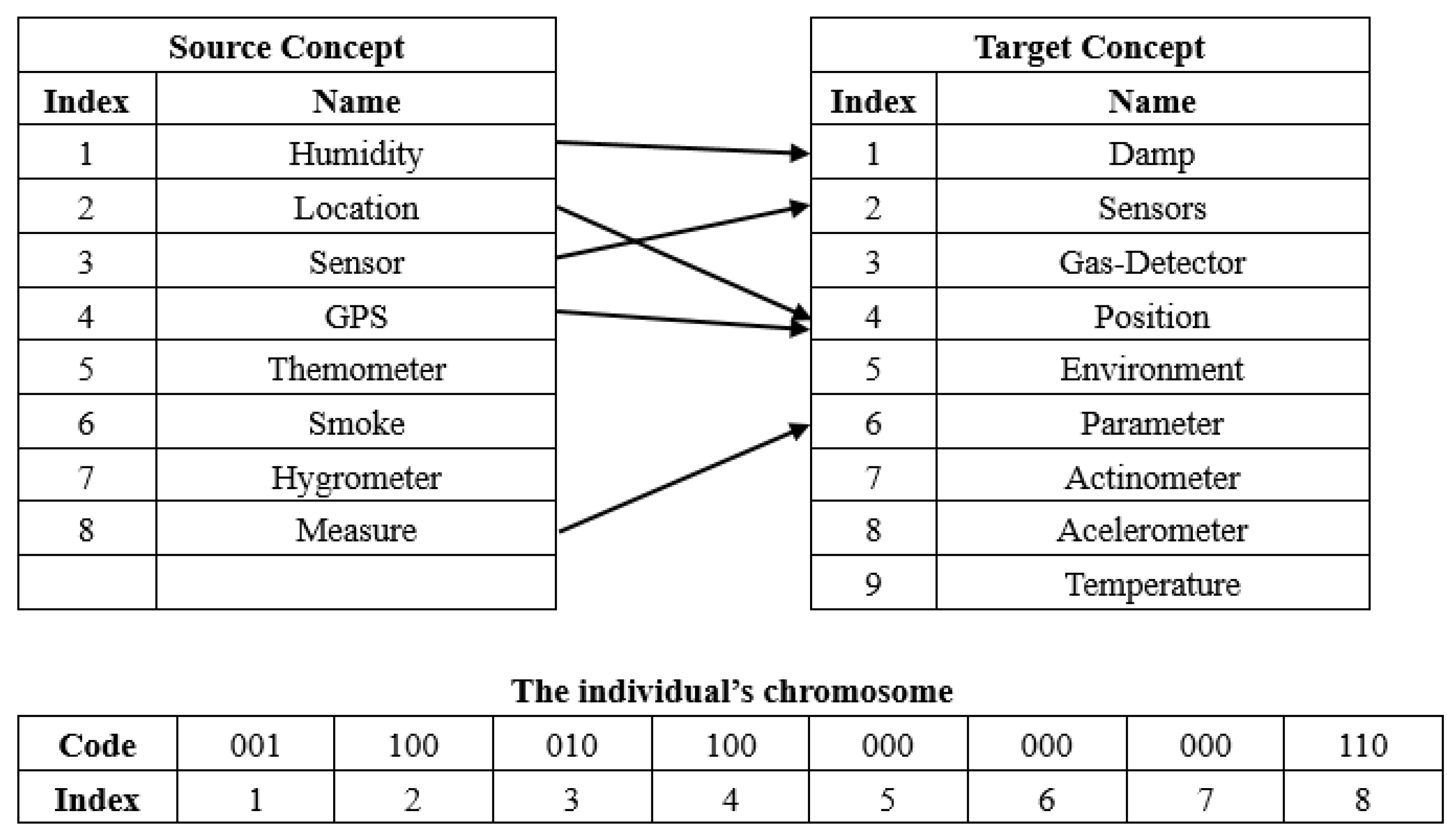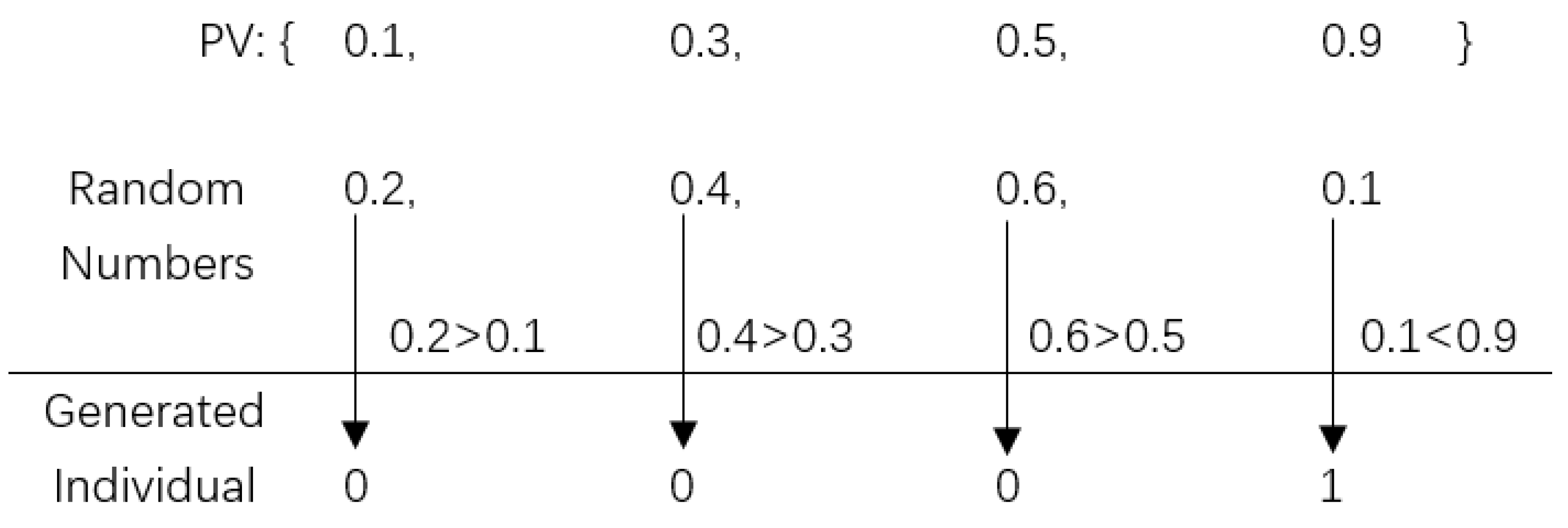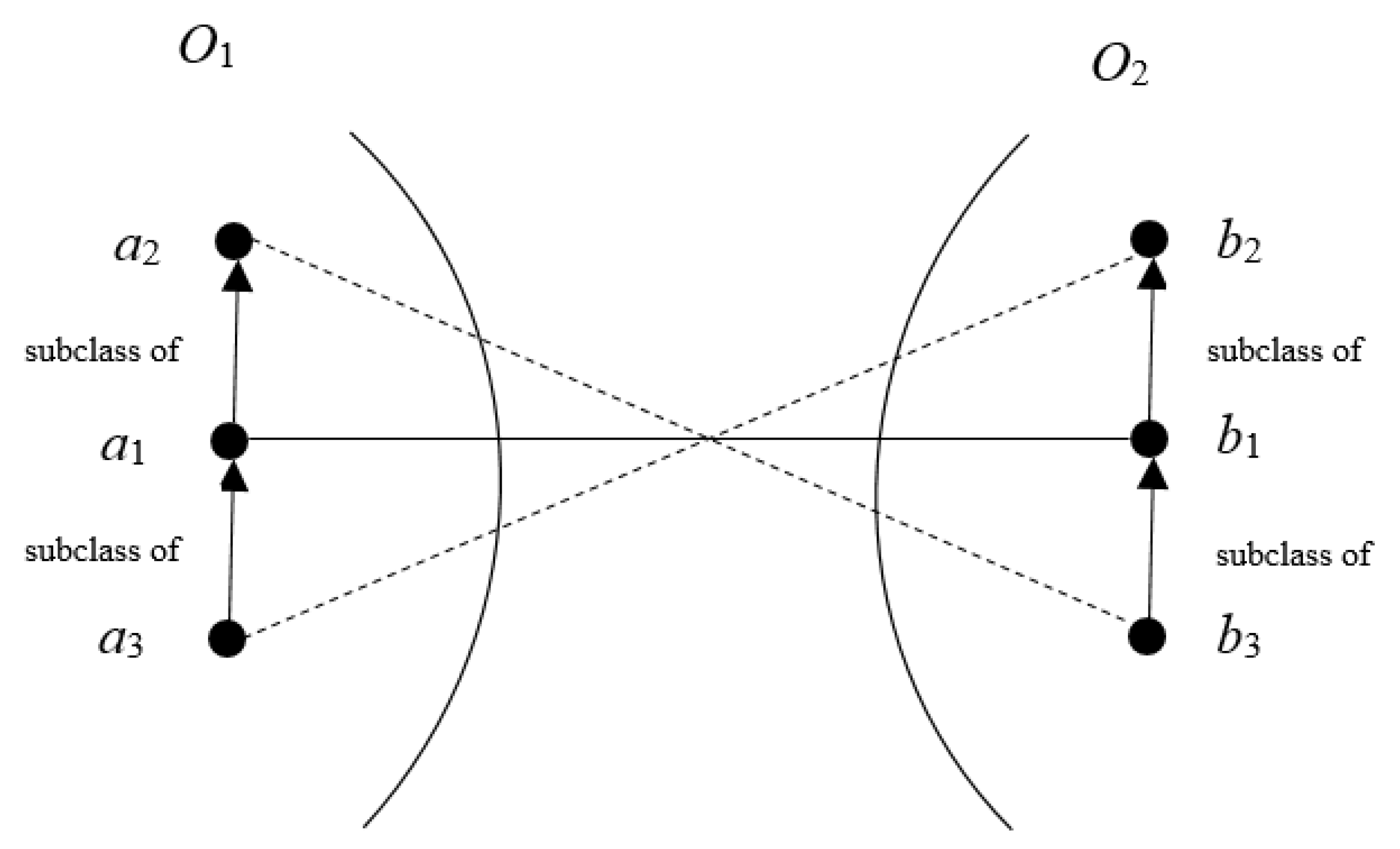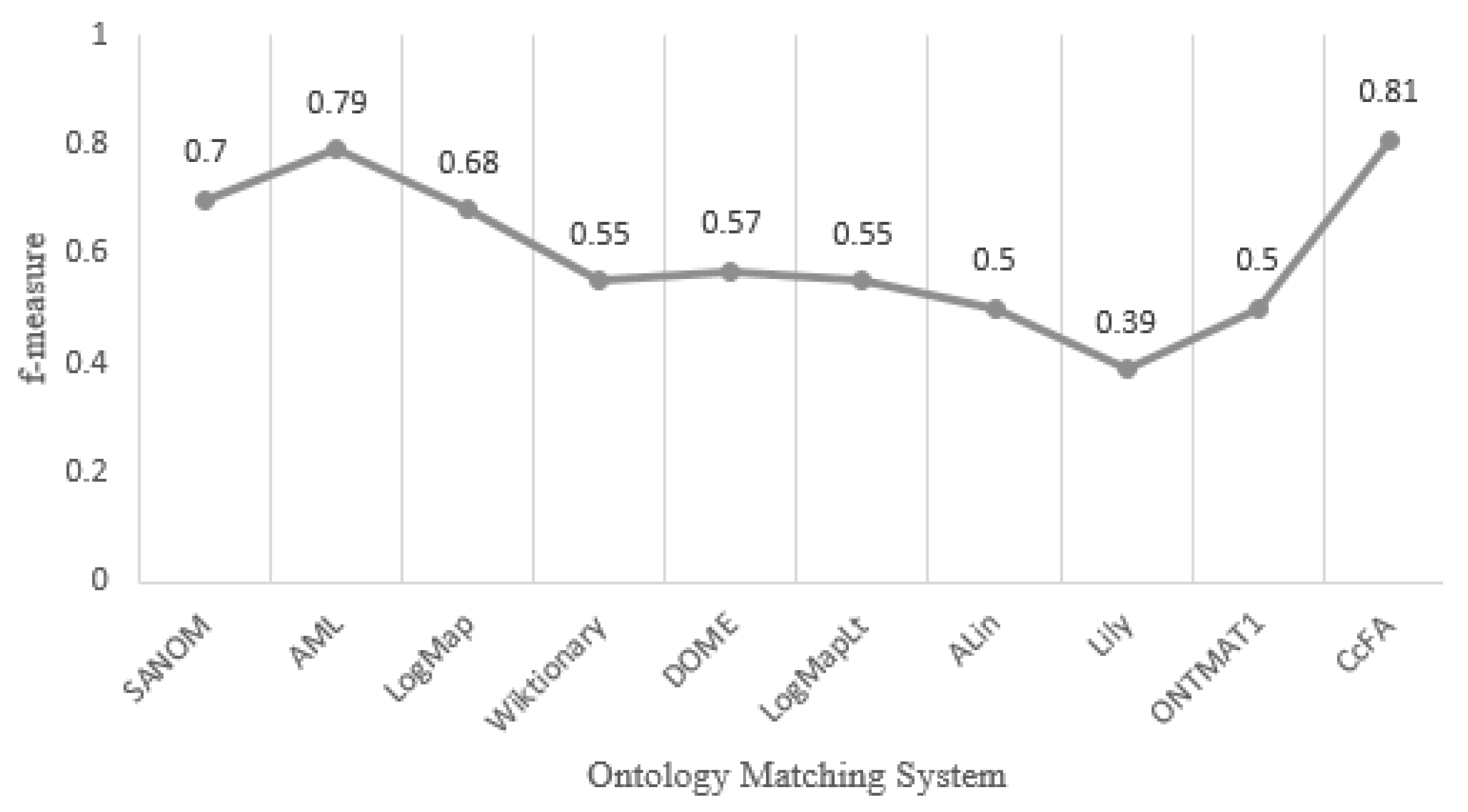Optimizing Sensor Ontology Alignment through Compact co-Firefly Algorithm
Abstract
1. Introduction
2. Swarm Intelligence Algorithm Based Ontology Alignment
3. Sensor Ontology Matching Problem
4. Compact co-Firefly Algorithm
4.1. Compact Encoding Mechanism
4.2. Movement Operator
4.2.1. Exploitation Strategy
| Algorithm 1-step Algorithm |
for int ; , i++ do generate a new solution through Probability Vector (PV); ; int ; while 0.6 do ; ; if then ; end if end while end for return the best individual in |
4.2.2. Exploration Strategy
| Algorithm 2-step Algorithm |
for ; ; k++ do if then put k into the list ; end if end for ; ; ; while do if then ; remove from ; ; end if ; end while |
4.3. Pseudo-Code of Compact co-Firefly Algorithm
| Algorithm 3 Compact co-Firefly Algorithm |
** Initialization ** ; Initialize and by setting all the probabilities inside as 0.5; generate and through and , respectively; ** Evolving Process ** while do ** Exploitation ** generate a solution through ; = -step(); // see also Algorithm 1 ** Competition ** ; if then ; end if ** PV Update ** for ; ; i++ do if then ; else ; end if end for ** Exploration ** generate a solution through ; = -step(, ); // see also Algorithm 2 ** Competition ** ; if then swap(; end if ** PV Update ** for ; ; i++ do if then ; else ; end if end for ** Communication ** ; if then swap(; swap(; end if update ; // see also Section 4.2.2 ** Judge whether the algorithm converges ** if all elements of and are equal to 1 or 0 then break; end if end while output ; |
5. Final Alignment Determination
6. Experiment
6.1. Experimental Configuration
6.2. The Results of Statistical Comparison
7. Conclusions and Future Work
Author Contributions
Funding
Conflicts of Interest
References
- Delin, K.A.; Jackson, S.P. Sensor web: A new instrument concept. In Proceedings of the SPIEs Symposium on Integrated Optics, San Jose, CA, USA, 20–26 January 2001. [Google Scholar]
- Corcho, O.; García-Castro, R. Five challenges for the semantic sensor web. Semantic Web 2010, 1, 121–125. [Google Scholar] [CrossRef]
- Wang, X.; Zhang, X.; Li, M. A survey on semantic sensor web: Sensor ontology, mapping and query. Int. J. u-e-Serv. Sci. Technol. 2015, 8, 325–342. [Google Scholar]
- Sheth, A.P.; Henson, C.; Sahoo, S.S. Semantic sensor web. IEEE Internet Comput. 2008, 12, 78–83. [Google Scholar] [CrossRef]
- Xue, X.; Pan, J.S. A Compact Co-Evolutionary Algorithm for sensor ontology meta-matching. Knowl. Inf. Syst. 2017, 56, 335–353. [Google Scholar] [CrossRef]
- Acampora, G.; Loia, V.; Vitiello, A. Enhancing ontology alignment through a memetic aggregation of similarity measures. Inf. Sci. 2013, 250, 1–20. [Google Scholar] [CrossRef]
- Harik, G.R.; Lobo, F.G.; Goldberg, D.E. The compact genetic algorithm. IEEE Trans. Evol. Comput. 1999, 3, 287–297. [Google Scholar] [CrossRef]
- Baraglia, R.; Hidalgo, J.I.; Perego, R. A hybrid heuristic for the traveling salesman problem. IEEE Trans. Evol. Comput. 2001, 5, 613–622. [Google Scholar] [CrossRef]
- Ahn, C.W.; Ramakrishna, R.S. Elitism based compact genetic algorithms. IEEE Trans. Evol. Comput. 2003, 7, 367–385. [Google Scholar]
- Neri, F.; Mininno, E.; Karkkainen, T. Noise analysis compact genetic algorithm. In Proceedings of the 2010 European Conference on the Applications of Evolutionary Computation, Istanbul, Turkey, 7–9 April 2010; pp. 602–611. [Google Scholar]
- Neri, F.; Mininno, E.; Iacca, G. Compact particle swarm optimization. Inf. Sci. 2013, 239, 96–121. [Google Scholar] [CrossRef]
- Mininno, E.; Neri, F.; Cupertino, F.; Naso, D. Compact differential evolution. IEEE Trans. Evol. Comput. 2010, 15, 32–54. [Google Scholar] [CrossRef]
- Tan, K.; Yang, Y.; Goh, C. A distributed cooperative coevolutionary algorithm for multiobjective optimization. IEEE Trans. Evol. Comput. 2006, 10, 527–549. [Google Scholar] [CrossRef]
- Mu, C.; Jiao, L.-C.; Liu, Y. M-Elite coevolutionary algorithm for numerical optimization. Journal of software 2009, 20, 2925–2938. [Google Scholar] [CrossRef]
- Wang, X.; Liu, Q.; Fu, Q.; Zhang, L. Double elite coevolutionary genetic algorithm. Int. J. Comput. Sci. Eng. 2011, 6, 67–75. [Google Scholar]
- El-Abd, M. Cooperative coevolution using the brain storm optimization algorithm. In Proceedings of the 2016 IEEE Symposium Series on Computational Intelligence (SSCI), Athens, Greece, 6–9 December 2016. [Google Scholar]
- Wang, H.; Wang, W.; Cui, L.; Sun, H.; Zhao, J.; Wang, Y.; Xue, Y. A Hybrid Multi-Objective Firefly Algorithm for Big Data Optimization. Appl. Soft Comput. 2018, 69, 806–815. [Google Scholar] [CrossRef]
- Karthikeyan, S.; Asokan, P.; Nickolas, S.; Page, T. A hybrid discrete firefly algorithm for solving multi-objective flexible job shop scheduling problems. Int. J. Bio-Inspired Comput. 2015, 7, 386–400. [Google Scholar] [CrossRef]
- Alboukaey, N.; Joukhadar, A. Ontology Matching as Regression Problem. J. Digit. Inf. Manag. 2018, 16, 1. [Google Scholar]
- Khoudja, M.A.; Fareh, M.; Bouarfa, H. Ontology Matching using Neural Networks: Survey and Analysis. In Proceedings of the 2018 International Conference on Applied Smart Systems (ICASS), Medea, Algeria, 24–25 November 2018. [Google Scholar]
- Dhouib, M.T.; Zucker, C.F.; Tettamanzi, A.G. An Ontology Alignment Approach Combining Word Embedding and the Radius Measure. In International Conference on Semantic Systems; Springer: Cham, Switzerland, 2019; pp. 191–197. [Google Scholar]
- Assi, A.; Mcheick, H.; Karawash, A.; Dhifli, W. Context-aware instance matching through graph embedding in lexical semantic space. Knowledge-Based Syst. 2019, 186, 104925. [Google Scholar] [CrossRef]
- Ali, F.; Kwak, K.S.; Kim, Y.G. Opinion mining based on fuzzy domain ontology and Support Vector Machine: A proposal to automate online review classification. Appl. Soft Comput. 2016, 47, 235–250. [Google Scholar] [CrossRef]
- Xue, X.; Pan, J.S. A segment-based approach for large-scale ontology matching. Knowl. Inf. Syst. 2017, 52, 467–484. [Google Scholar] [CrossRef]
- Amrouch, S.; Mostefai, S.; Fahad, M. Decision trees in automatic ontology matching. Int. J. Metadata, Semant. Ontol. 2016, 11, 180–190. [Google Scholar] [CrossRef]
- Araújo, T.B.; Pires, C.E.S.; Da Nóbrega, T.P.; Nascimento, D.C. A fine-grained load balancing technique for improving partition-parallel-based ontology matching approaches. Knowledge-Based Syst. 2016, 111, 17–26. [Google Scholar] [CrossRef]
- Amin, M.B.; Khan, W.A.; Hussain, S.; Bui, D.M.; Banos, O.; Kang, B.H.; Lee, S. Evaluating large-scale biomedical ontology matching over parallel platforms. Iete Tech. Rev. 2016, 33, 415–427. [Google Scholar] [CrossRef]
- Martinez-Gil, J.; Montes, J.F.A. Evaluation of two heuristic approaches to solve the ontology meta-matching problem. Knowl. Inf. Syst. 2011, 26, 225–247. [Google Scholar] [CrossRef]
- Ginsca, A.L.; Iftene, A. Using a genetic algorithm for optimizing the similarity aggregation step in the process of ontology alignment. In Proceedings of the 9th Roedunet International Conference, Sibiu, Romania, 24–26 June 2010; pp. 118–122. [Google Scholar]
- Xue, X.; Wang, Y. Optimizing ontology alignments through a Memetic Algorithm using both MatchFmeasure and Unanimous Improvement Ratio. Artif. Intell. 2015, 223, 65–81. [Google Scholar] [CrossRef]
- He, Y.; Xue, X.; Zhang, S. Using artificial bee colony algorithm for optimizing ontology alignment. J. Inf. Hiding Multimed. Sig. Process 2017, 8, 766–773. [Google Scholar]
- Xue, X.; Chen, J. A Compact co-Firefly Algorithm for Matching Ontologies. In Proceedings of the 2019 IEEE Symposium Series on Computational Intelligence (SSCI), Xiamen, China, 6–9 December 2019; pp. 2629–2632. [Google Scholar]
- Zhang, Q.; Li, H. MOEA/D: A multiobjective evolutionary algorithm based on decomposition. IEEE Trans. Evol. Comput. 2007, 11, 712–731. [Google Scholar] [CrossRef]
- Xue, X. A compact firefly algorithm for matching biomedical ontologies. Knowl. Inf. Syst. 2020, 1–17. [Google Scholar] [CrossRef]
- Shu-Chuan, C.; Xue, X.; Pan, J.S.; Wu, X. Optimizing Ontology Alignment in Vector Space. J. Internet Tech. 2020, 21, 15–22. [Google Scholar]
- Miller, G.A. WordNet: A lexical database for English. Commun. ACM 1995, 38, 39–41. [Google Scholar] [CrossRef]
- Kondrak, G. N-gram similarity and distance. In Proceedings of the International symposium on string processing and information retrieval, Buenos Aires, Argentina, 2–4 November 2005; pp. 115–126. [Google Scholar]
- Fernandez, S.; Marsa-Maestre, I.; Velasco, J.R.; Alarcos, B. Ontology alignment architecture for semantic sensor web integration. Sensors 2013, 13, 12581–12604. [Google Scholar] [CrossRef]
- Wang, P. Lily-LOM: An efficient system for matching large ontologies with non-partitioned method. In Proceedings of the 2010 International Conference on Posters & Demonstrations Track, Shanghai, China, 9 November 2010; pp. 69–72. [Google Scholar]
- Zamazal, O.; Svátek, V. The ten-year ontofarm and its fertilization within the onto-sphere. J. Web Semant. 2017, 43, 46–53. [Google Scholar] [CrossRef]
- Wang, J.; Ding, Z.; Jiang, C. GAOM: Genetic algorithm based ontology matching. In Proceedings of the 2006 IEEE Asia-Pacific Conference on Services Computing (APSCC’06), Guangzhou, China, 12–15 December 2006; pp. 617–620. [Google Scholar]
- Bock, J.; Hettenhausen, J. Discrete particle swarm optimisation for ontology alignment. Inf. Sci. 2012, 192, 152–173. [Google Scholar] [CrossRef]
- Xu, P.; Wang, Y.; Cheng, L.; Zang, T. Alignment Results of SOBOM for OAEI 2010. Ontol. Matching 2010, 203, 7–11. [Google Scholar]
- Noessner, J.; Niepert, M.; Meilicke, C.; Stuckenschmidt, H. Leveraging terminological structure for object reconciliation. In Proceedings of the Extended Semantic Web Conference, Heraklion, Greece, 30 May–3 June 2010; pp. 334–348. [Google Scholar]
- Jean-Mary, Y.R.; Shironoshita, E.P.; Kabuka, M.R. Ontology matching with semantic verification. J. Web Semant. 2009, 7, 235–251. [Google Scholar] [CrossRef]
- Rijsberge, C.J.V. Information Retrieval; University of Glasgow: London, UK, 1975. [Google Scholar]
- Friedman, M. The use of ranks to avoid the assumption of normality implicit in the analysis of variance. J. Am. Stat. Assoc. 1937, 32, 675–701. [Google Scholar] [CrossRef]
- Holm, S. A simple sequentially rejective multiple test procedure. Scand. J. Stat. 1979, 65–70. [Google Scholar]
- Janowicz, K.; Haller, A.; Cox, S.J.; Le Phuoc, D.; Lefrançois, M. SOSA: A lightweight ontology for sensors, observations, samples, and actuators. J. Web Semant. 2019, 56, 1–10. [Google Scholar] [CrossRef]
- Bermudez-Edo, M.; Elsaleh, T.; Barnaghi, P.; Taylor, K. IoT-Lite: A lightweight semantic model for the Internet of Things. In Proceedings of the 2016 Intl IEEE Conferences on Ubiquitous Intelligence & Computing, Advanced and Trusted Computing, Scalable Computing and Communications, Cloud and Big Data Computing, Internet of People, and Smart World Congress (UIC/ATC/ScalCom/CBDCom/IoP/SmartWorld), Toulouse, France, 18–21 July 2016; pp. 90–97. [Google Scholar]
- Thiéblin, E.; Haemmerlé, O.; Hernandez, N.; Trojahn, C. Survey on complex ontology matching. Semant. Web 2019, 1–39. [Google Scholar] [CrossRef]
- Ritze, D.; Meilicke, C.; Šváb-Zamazal, O.; Stuckenschmidt, H. A pattern-based ontology matching approach for detecting complex correspondences. In Proceedings of the ISWC Workshop on Ontology Matching, Chantilly, VA, USA, 25 October 2009; pp. 25–36. [Google Scholar]
- Xue, X.; Wang, Y. Using memetic algorithm for instance coreference resolution. IEEE Trans. Knowl. Data Eng. 2015, 28, 580–591. [Google Scholar] [CrossRef]




| Name | Class Scale | Datatype Property Scale | Object Property Scale |
|---|---|---|---|
| Cmt | 36 | 10 | 49 |
| Pcs | 23 | 14 | 24 |
| OpenConf | 62 | 21 | 24 |
| Edas | 104 | 20 | 30 |
| Ekaw | 77 | 0 | 33 |
| Iasted | 140 | 3 | 38 |
| Sigkdd | 49 | 11 | 17 |
| MMI Device ontology | 55 | 43 | 28 |
| SSN ontology | 19 | 2 | 36 |
| CSIRO sensor ontology | 75 | 11 | 61 |
| Matching Task | SOBOM | CODI | ASMOV | FuzzyAlign | EA | PSO | CcFA |
|---|---|---|---|---|---|---|---|
| OAEI’s Conference Track | |||||||
| Cmt-Pcs | 0.50(7) | 0.75(5) | 0.59(6) | 0.87(2) | 0.82(4) | 0.85(3) | 0.91(1) |
| Cmt-OpenConf | 0.21(7) | 0.38(5) | 0.28(6) | 0.45(3) | 0.40(4) | 0.48(1.5) | 0.48(1.5) |
| Cmt-Edas | 0.48(6) | 0.75(5) | 0.42(7) | 0.86(1.5) | 0.78(3.5) | 0.78(3.5) | 0.86(1.5) |
| Cmt-Ekaw | 0.52(7) | 0.75(3) | 0.59(6) | 0.88(2) | 0.66(4) | 0.64(5) | 0.92(1) |
| Cmt-Iasted | 0.54(6) | 0.78(5) | 0.50(7) | 0.87(2.5) | 0.82(4) | 0.87(2.5) | 0.90(1) |
| Cmt-Sigkdd | 0.14(7) | 0.68(2) | 0.34(6) | 0.61(4) | 0.60(5) | 0.64(3) | 0.72(1) |
| Pcs-OpenConf | 0.40(7) | 0.75(4) | 0.51(6) | 0.86(2) | 0.74(5) | 0.80(3) | 0.89(1) |
| Pcs-Edas | 0.44(7) | 0.75(5) | 0.50(6) | 0.88(1.5) | 0.83(4) | 0.86(3) | 0.88(1.5) |
| Pcs-Ekaw | 0.38(6) | 0.70(5) | 0.32(7) | 0.87(2) | 0.83(4) | 0.86(3) | 0.90(1) |
| Pcs-Iasted | 0.54(6) | 0.73(5) | 0.50(7) | 0.89(2) | 0.84(3) | 0.82(4) | 0.93(1) |
| Pcs-Sigkdd | 0.40(7) | 0.70(5) | 0.59(6) | 0.80(2) | 0.77(3) | 0.75(4) | 0.85(1) |
| OpenConf-Edas | 0.14(7) | 0.36(5) | 0.27(6) | 0.59(2) | 0.50(3) | 0.56(4) | 0.67(1) |
| OpenConf-Ekaw | 0.25(7) | 0.41(4.5) | 0.28(6) | 0.52(2) | 0.44(3) | 0.41(4.5) | 0.54(1) |
| OpenConf-Iasted | 0.20(7) | 0.70(5) | 0.31(6) | 0.71(4) | 0.79(1.5) | 0.75(3) | 0.79(1.5) |
| OpenConf-Sigkdd | 0.35(7) | 0.61(5) | 0.48(6) | 0.82(2.5) | 0.82(2.5) | 0.79(4) | 0.85(1) |
| Edas-Ekaw | 0.10(7) | 0.25(6) | 0.39(4) | 0.44(2) | 0.34(5) | 0.41(3) | 0.54(1) |
| Edas-Iasted | 0.32(6) | 0.72(3) | 0.20(7) | 0.84(2) | 0.62(5) | 0.70(4) | 0.88(1) |
| Edas-Sigkdd | 0.25(7) | 0.58(5) | 0.33(6) | 0.66(3) | 0.69(2) | 0.65(4) | 0.73(1) |
| Ekaw-Iasted | 0.30(7) | 0.64(5) | 0.37(6) | 0.87(2) | 0.81(4) | 0.82(3) | 0.94(1) |
| ekaw-Sigkdd | 0.22(7) | 0.78(3) | 0.25(6) | 0.74(1.5) | 0.70(4) | 0.68(5) | 0.74(1.5) |
| Iasted-Sigkdd | 0.17(7) | 0.72(5) | 0.20(6) | 0.77(2) | 0.74(3.5) | 0.74(3.5) | 0.83(1) |
| Three Pairs of Real Sensor Ontologies | |||||||
| MMI Device-SSN | 0.77(7) | 0.80(5) | 0.73(6) | 0.88(2) | 0.82(4) | 0.85(3) | 0.92(1) |
| CSIRO-SSN | 0.78(5.5) | 0.79(4) | 0.75(6) | 0.88(2) | 0.78(5.5) | 0.87(3) | 0.94(1) |
| MMI Device-CSIRO | 0.72(7) | 0.78(4) | 0.75(5) | 0.87(2) | 0.74(6) | 0.82(3) | 0.90(1) |
| Average | 0.38 (6.72) | 0.66 (4.52) | 0.43 (6.08) | 0.76 (2.22) | 0.70 (3.85) | 0.72 (3.43) | 0.89 (1.10) |
| i | Approach | Value | Unadjusted Value | |
|---|---|---|---|---|
| 8 | FuzzyAlign | 2.22 | 0.030 | 0.050 |
| 7 | EA | 3.43 | 1.91 | 0.025 |
| 5 | PSO | 3.85 | 1.08 | 0.012 |
| 3 | CODI | 4.52 | 4.25 | 0.008 |
| 2 | ASMOV | 6.08 | 1.55 | 0.007 |
| 1 | SOBOM | 4.45 | 4.24 | 0.006 |
© 2020 by the authors. Licensee MDPI, Basel, Switzerland. This article is an open access article distributed under the terms and conditions of the Creative Commons Attribution (CC BY) license (http://creativecommons.org/licenses/by/4.0/).
Share and Cite
Xue, X.; Chen, J. Optimizing Sensor Ontology Alignment through Compact co-Firefly Algorithm. Sensors 2020, 20, 2056. https://doi.org/10.3390/s20072056
Xue X, Chen J. Optimizing Sensor Ontology Alignment through Compact co-Firefly Algorithm. Sensors. 2020; 20(7):2056. https://doi.org/10.3390/s20072056
Chicago/Turabian StyleXue, Xingsi, and Junfeng Chen. 2020. "Optimizing Sensor Ontology Alignment through Compact co-Firefly Algorithm" Sensors 20, no. 7: 2056. https://doi.org/10.3390/s20072056
APA StyleXue, X., & Chen, J. (2020). Optimizing Sensor Ontology Alignment through Compact co-Firefly Algorithm. Sensors, 20(7), 2056. https://doi.org/10.3390/s20072056






